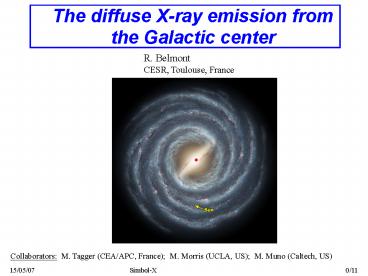The diffuse X-ray emission from the Galactic center PowerPoint PPT Presentation
Title: The diffuse X-ray emission from the Galactic center
1
The diffuse X-ray emission from the Galactic
center
R. Belmont CESR, Toulouse, France
Collaborators M. Tagger (CEA/APC, France) M.
Morris (UCLA, US) M. Muno (Caltech, US)
2
Outline
- The diffuse emission issue at the Galactic center
- Diffuse plasma ?
- Unresolved discrete point sources ?
- Ideas to solve the diffuse plasma paradox
- Confinement of the plasma ? Heavy helium plasma
- Heating ? Viscous friction with dense molecular
clouds
3
The Galactic Center Region
- Central zone
- X-ray view
- Strong emission
- Radio view
- Non thermal filaments
- ? Vertical B (10?G - 1mG)
- IR view
- The central molecular zone (MorrisSerabyn 1996)
- Gas condensed in clouds (Bally et al. 87)
N100, R 5 pc, v 100 km s-1
4
The GC X-ray emission
At the Galactic center The diffuse emission (DE)
profile is different from that of the resolved
point sources (RPS) emission (Suzaku, Koyama et
al. 2006). ? diffuse plasma ?
5
Problems with a diffuse plasma ?(Kaneda et al.,
1997)
- Energy problem confinement of the plasma
- cs 1500km/s vesc 1100-1200 km/s ?
the gas escapes - very fast escape tesc 40 000 yr
- required power is huge (gt 1 SN/3-300 yr in the
central region) - Heating mechanism
- If confined radiative cooling time 108 yr
- Heating mechanism still needed
6
Confining the plasma (Belmont et al. 2005)
- Species of different mass have different wills
- - As in planetary atmospheres confinement ?
comparison of vth and vesc - - 1-species plasma (e-)
7
The hot He plasma vs. Observations
- At 8 keV, H ad He are fully ionized
- ? no direct diagnostic on the major species
- Re-interpretation of spectral data
- ? weaker number densities n(He) 0.3 n(H)
- ? Similar e- and mass densities
- ? Smaller abundances (Fe/He)He 0.3
(Fe/He)H - ? Recent observations with Suzaku Fe 3.5
Fesolar ? He plasma with solar abundances - Stratification
- ? Heavy ions could sediment (?sed 108 yr)
- If the stratification is observed (He continuum,
Fe line) evidence for a plasma confined by
gravity - The origin of the continuum is uncertain
(confusion from the many components). - Observation at energy gt 7 keV (Fe and Ni lines
continuum) with Simbol-X will clarify the
spectral components in this spectral region. - ? Spectra at several latitudes may give access to
the vertical structure of the plasma for the iron
line and the He continuum.
8
A possible heating mechanism
- Radiative cooling of the confined plasma
- Heating by the dissipation of the gravitational
and kinetic energy of molecular clouds by the
strong viscosity (Re 10-2)
- Dissipation efficiency
- - Strong viscous coefficient
- - Subsonic motion vc lt cs lt va ? weak
compression - - The precise flow structure around clouds must
be studied
9
The inviscid Alfvén wake
- Alfvén wing
- (Drell et al. 1965, Neubauer 1980)
- Echo-I in the earth magnetosphere
- Io in the Jovian magnetosphere
strong energy flux !
10
Viscous dissipation
Dissipation by - Non linear effects -
Curvature of the field lines
Strong outgoing Alfvén flux !
- For most of the expected values for the magnetic
field, dissipation in the Alfvén wings
(BelmontTagger 2006) - is very efficient
- balance the radiative cooling
- can account for the observed hot plasma
? 3D-MHD numerical simulations with the Zeus code
are in progress to validate and extend these
results
11
Conclusion
- The diffuse plasma issue is particularly
interesting at the GC - Stronger gravitational potential
- High concentration of molecular gas
- Vertical structured magnetic field
- Its nature is very debated.
- Point sources (CVs) not enough of them ?
- Diffuse plasma should not exist since it must
escape - The escape of light protons naturally leaves a
confined plasma made of He - Its heating can be achieved by the viscous
dissipation of the kinetic energy of molecular
clouds.
12
And Simbol-X
- General input for the GRGC diffuse emission
(previous talks) - Thermal/Non thermal nature
- lines high energy continuum
- Diffuse plasma/Discrete sources
- High resolution mapping at high energy
- Precise source identification and counting at
high energy - Specific input for the GC diffuse emission
- Good identification at high energy where the
source confusion is high - Look for vertical stratification (thanks to
better constrains at high energy on the continuum
origin)

